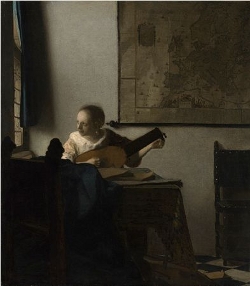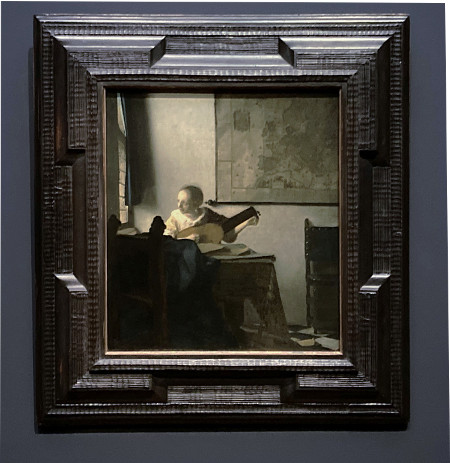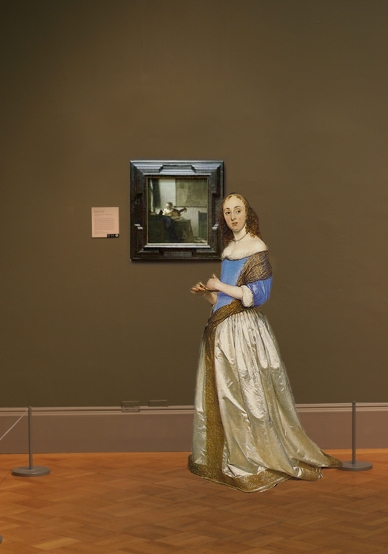Woman with a Lute
(De luitspelster)c. 1662–1665
Oil on canvas, 51.4 x 45.7 cm. (20 1/4 x 18 in.)
Metropolitan Museum of Art, New York
acc. no. 25.110.24
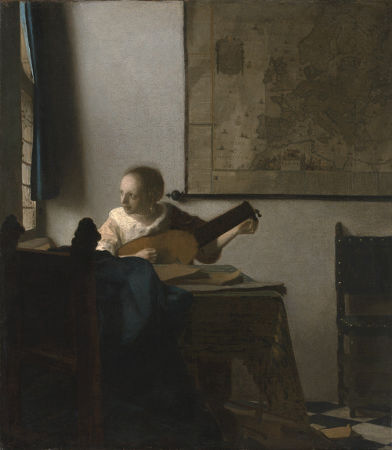
The textual material contained in the Essential Vermeer Interactive Catalogue would fill a hefty-sized book, and is enhanced by more than 1,000 corollary images. In order to use the catalogue most advantageously:
1. Scroll your mouse over the painting to a point of particular interest. Relative information and images will slide into the box located to the right of the painting. To fix and scroll the slide-in information, single click on area of interest. To release the slide-in information, single-click the "dismiss" buttton and continue exploring.
2. To access Special Topics and Fact Sheet information and accessory images, single-click any list item. To release slide-in information, click on any list item and continue exploring.
The map of Europe

An engraving by Jodocus Hondius
1619
This map of Europe can reasonably be identified with one that first appeared around 1613 under the name of the Dutch cartographer Jodocus Hondius. Only a single example from this edition survives in the collection of the University Library of Amsterdam. A second state was printed in 1659 by another mapmaker, Joan Blaeu. Blaeu's name replaced the name of Hondius in the title and dedication cartouches. It is impossible to know if Vermeer painted the first or second edition. Both maps are framed with a text written in Latin, Dutch and French and contain brief descriptions of various European nations.
Map specialists note that even the minutest features of Vermeer's map have been reproduced with considerable fidelity. London architect and Vermeer/camera obscura expert Philip Steadman calculated the estimated size of the painted map would differ only four centimeters from the map's real size. Steadman believes that such accuracy could only be achieved by tracing from the camera obscura, although the squaring method can be adapted to attain similar exactitude.
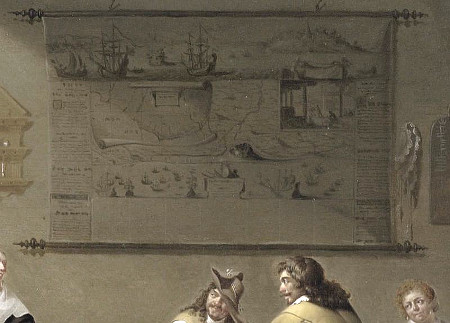
A Bordello Scene (detail)
Jacob Duck
c. 1600–1667
Oil on panel, 41.3 x 54 cm.
Private collection
Although large wall maps are represented in an extraordinary number of Dutch interior paintings, only Vermeer lavished such attention on them. One has the impression that for other Dutch painters, maps were little more than facile decorative fillers. Only Vermeer's maps convey the effects of daylight as it rakes across the soft undulations, cracks and crevices caused by old age. And only in Vermeer's maps do we find the topographical intricacies so faithfully reproduced that surviving maps match perfectly in both detail and overall proportion. In short, for Vermeer, maps are objects worthy of being painted as much as any other object or figure.
Vermeer's maps present serious problems for those art historians who wish to see maps as carriers of symbolic meaning. While most believe that they usually represent something other than themselves, there is no historical evidence that indicates maps, or for that matter any other object/prop found in Dutch genre painting, might be utilized to convey hidden messages.
Who posed for the painting?

None of Vermeer's sitters has been objectively identified. Nonetheless, critics have suggested that his wife, Catharina or one of his daughters, Maria (born c. 1654) or Elisabeth (born 1657), modeled for some of his paintings. In any case, the prognathous girl with the widely spaced eyes resembles, perhaps, the young sitter in the Study of a Young Girl in the Metropolitan (face below left). Certainly, neither could be considered a beauty in a conventional sense, but the empathy and warmth with which they are portrayed suggest that they were linked to the painter not only by art.
In keeping with the fashion of their time, the three young women in Woman with a Lute, A Lady Writing and Study of a Young Girl have shaved eyebrows and foreheads in common. Although highly fashionable, the use of cosmetics and beauty technology was criticized by conservative thinkers. In 1682, Utrecht schoolmaster Simon de Vries wrote, "Discomfort also goes with pride. This can be attested to by those who pull out the hair at the top of their forehead with little tongs or pincers in order to give this a broader appearance, or out of their eyebrows to make them thinner."
Although dating back to ancient times, it is known that fifteenth-century women often plucked or shaved their hairline back several inches in the belief that the high forehead was a sign of intelligence. To complete the effect, they tweezed their eyebrows. The fashion for high foreheads continued through the 17th and 18th centuries, prompting women of the higher social classes to raise their hairlines by at least one inch. Preferred methods for hair removal included shaving, plucking or applying a plaster of quicklime. After letting it dry, they would strip it off, taking the hair with it. Even eyebrows were often entirely plucked or waxed away.
The lute
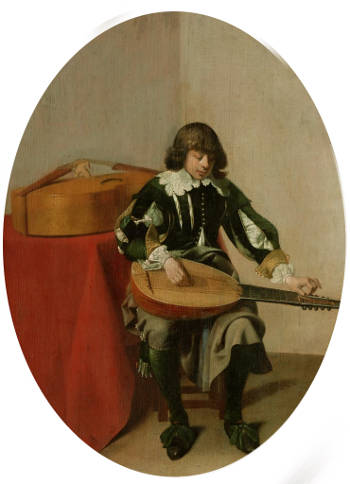
A Man Tuning a Lute
Willem Cornelisz. Duyster
Despite the poor condition of the painting, lute expert Lynda Sayce notes that the projecting peg for the treble string (in its little rider) indicates an instrument with 10 or 11 courses (pairs of strings). An 11-course lute would be the expected type for the date, but if the lute was a studio prop owned by the painter, it might be rather out of date.
The young lady is not actually playing the lute; she is tuning it. There are numerous Dutch paintings of musicians tuning their instruments. Since it was a well-known fact that the lute goes out of tune often, it may be that it had a subtle bearing on the meaning of the painting, which was evident to contemporary observers. A running joke among lutenists was that one spent more time tuning than playing the instrument. The lute was also used as a solo instrument, and musicians found that it could be played with fingertips as well as with a quill. With the introduction of the guitar, harpsichord and the larger orchestra, the lute, with its soft voice, quickly fell out of favor and virtually disappeared from the musical stage for two hundred years.
The lute had extremely rich iconographical associations. While its sensuous and delicate tones evoked the pleasures of love, the fleeting nature of its sound and the physical fragility of the instrument made it a fitting emblem of transience and death—it is often included, sometimes alongside a skull. On the other hand, it could serve as an erotic symbol, a metaphor for female genitals or an attribute of lust. Obviously, it functioned most often as a more-or-less neutral amorous symbol and convenient prop, which seems to be the case in the present painting.
The "Spanish" chair

Although generally unnoticed, there are two different types of chairs in the present works: the foreground chair presents two large oval-shaped lion-head finials which are comparable to those in other works by Vermeer such as Officer and Laughing Girl and Girl with a Pearl Earring. The finials of the background chair, instead, are more slender, similar to those of the Woman in Blue Reading a Letter, although the upholstery of the chair in the Woman with a Lute is a deep unsaturated blue, which, however, may be due to the painting's disastrous state of conservation.
Early critics were disturbed by the discrepancy of the dimensions between the two finials, which in reality must have been the same or very similar. The foreground finial, set flush against the face of the young musician, is on the picture's plane the same size, even though such a finial could easily fit into the palm of one's hand. This "fault" was typically avoided by genre painters. However, with the advent of serious studies of the use of the camera obscura and linear perspective in the paintings of Vermeer, it became clear that the proportions of the two finials and the girl's head are perfectly logical, obeying the laws of geometric perspective to the tee. The seemingly exaggerated size of the foreground finials is due simply to the fact that the painter was seated very near the chair, perhaps not much more than a meter or two away.
The effect, no doubt, must have been pursued by Vermeer deliberately in order to make the viewer, who subliminally perceives the scene from the same point from which it was painted, an participant part of the picture, not just a observer who passively views the scene from a more comfortable distance.
Very few of these so-called Spanish chairs have survived till today. Some are still housed in the Prinsenhof Museum in Delft, although they are generally not on display. Another is exhibited in the Rijksmuseum.
Did Vermeer use a camera obscura to paint this picture?
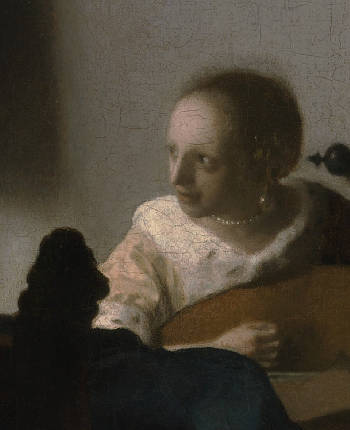
The disproportionate size of the lion-head finial has led some scholars to believe that Vermeer used a camera obscura (a kind of precursor to the modern photographic camera) as an aid to his painting. While it is true that certain aspects of Vermeer's painting recall some of the peculiarities of the camera obscura image, scholars such as Walter Liedtke believe they may be stylistic in origin.
The nearly monumental size of the finial, which in reality could easily fit in the hand of the young lute player, obeys the laws of linear perspective and, thus, cannot necessarily be attributed to the camera obscura. Its apparent distortion is due to the fact that the artist sat extremely close to the table, perhaps only a yard or two away.
Music books
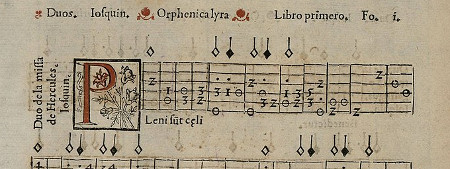
Sample of numeric vihuela tablature from
the book Orphenica Lyra by Miguel
de Fuenllana (1554)
Although no sort of notation is visible, the large folios on the top of the table are no doubt songbooks with lute tablature.
Over its long and illustrious history, a truly vast repertoire was created for the lute in tablature form. American scholar Arthur Ness has estimated that 25,000 pieces survive for the Renaissance lute, and probably as many for the Baroque instruments. This figure comprises only the music specially notated in lute tablature and does not account for music from the Medieval and Baroque eras which is written in normal staff notation. Even at the time, Dutch music was considered unremarkable. Music books, mostly French and Italian, were avidly collected by Dutch musicians.
While standard musical notation represents the rhythm and duration of each note and its pitch relative to the scale based on a 12-tone division of the octave, tablature is instead operationally based, indicating where and when a finger should be placed to generate a note, so the pitch is denoted implicitly rather than explicitly. The rhythmic symbols of tablature tell when to begin a note, but usually, there is no indication of when to stop sounding it, so duration is at the discretion of the performer to a greater extent than is the case in conventional musical notation. Lute music was written in tablature before 1500.
The practice of reading and interpreting tablature was not limited to lute music. Tablature has been used for various instruments throughout history, including the guitar, keyboard instruments and even the harmonica. It offers a unique way of conveying musical information that is more closely tied to the physical act of playing an instrument, making it accessible to musicians with different levels of formal musical training. Despite its advantages, it eventually lost popularity and nearly died out, remaining in informal use amongst amateurs, aficionados and folk idioms and beginner guitar-lesson books.
The viola di gamba underneath the table
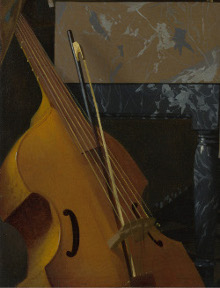
A Lady Seated at a Virginal (detail)
Johannes Vermeer
c. 1670–1675
Oil on canvas, 51.5 x 45.5 cm.
National Gallery, London
The viola da gamba, "viol" or "viola" as it is also known, that lies on the marble floor makes four appearances, presumably iconographically significant, in Vermeer's musical-themed paintings: The Music Lesson, the Woman with a Lute, The Concert and A Lady Seated at a Virginal (detail left). Never once is it portrayed being played. It remains quietly unattended, perhaps awaiting someone who will gather it up and make music or who has just left the performance.
In the present work, the viol is almost impossible to make out due to the picture's poor state of conservation. The only things that can be discerned are the bow, the bridge, the tailpiece and one of the "C-holes," which help to project and shape the instrument's sound. When looking at this picture, one must try to imagine the instrument's appearance, perhaps not far from the same instrument in The Concert, which is only slightly better conserved, or the Music Lesson, where it appears in broad daylight, not to mention A Lady Seated at a Virginal, which is one of Vermeer's most eloquent passages.
A viola is a bowed string instrument. Similar to the cello, the viola da gamba, is played between the legs (hence the name, "leg-viol"). Although the viola da gamba superficially resembles a cello, it is different in numerous ways from instruments of the violin family. Together with the lute, the viola da gamba is probably the most frequently represented instrument throughout the centuries, whether in painting, sculpture or miniature. It frequently appears in companionship with the lute. These two instruments—the viol with its soft but clear tone which comes very close to imitating the human voice—and the lute complement one another perfectly. Both stand for harmony and concord enhancing this meaning further if they both appear in the same painting.
The viola has held iconographic significance in painting throughout history. In various artistic contexts, it has symbolized different themes and ideas, adding layers of meaning to the compositions in which it appears.
Due to its imposing dimensions and deep sound, the viola has always been associated with the male. When not played, it is often represented alongside other musical instruments, in a harmonious combination. When both the viola and the lute are present in a painting, they can enhance the meaning of harmony further, reflecting the unity of different elements.
If such an interpretation was in the mind of Vermeer when he composed the Woman with a Lute, the fact that the instrument is concealed in the deepest shadow of the painting may have had some bearing on its use as a symbol, although it is impossible to know. This, perhaps, illustrates the pitfalls of scholarly interpretation, which generally initiates from the assumption that everything we see in Vermeer's compositions must have had a distinct and recoverable symbolic meaning, ignoring that some objects might have only had a decorative or compositional significance.
The fur-trimmed morning jacket

If we are to believe the generally accepted chronological order of Vermeer's paintings, the light-yellow, fur-trimmed "morning" jacket appears for the first time in the present work. A similar jacket appears in five other paintings by Vermeer. This type of casual but elegant jacket was worn by middle- and upper-class women to protect them against the cold during the long Dutch winters as they performed household chores. The fur was more likely made of white squirrel, mouse or even cat. The one in Vermeer's pictures probably belonged to Vermeer's wife, Catharina Bolnes. In Vermeer's probate inventory of 1676, a "yellow satin mantle with white fur trimmings" was found in the groote zael (great hall). Judging by its poor appearance, like every other part of the painting, the jacket has undergone a troubled past. Five or six dark spots can be seen on the fur trim, but otherwise, it pales in comparison to versions of the same garment in Woman with a Pearl Necklace and A Lady Writing or Mistress and Maid, increasing, perhaps, the melancholy of the painting's already wistful atmosphere.
Most writers of the past have mistaken the candid fur trim for ermine, but Dutch costume expert Marieke de Winkel revealed that even in the inventories of the wealthiest women, this particular fur is never mentioned, but it is more likely to have been white squirrel or possibly cat fur. According to financial records from 1655—the year she got married—Wendela Bicker, wife of Johan de Witt, possessed a green velvet jacket with sable lining and white fur trim, another green wool jacket lined with cat fur and a white satin jacket lined with a pinkish-red material and padded with cotton, but no ermine.
In any case, the ermine's (stoat's) white winter coloration, typically tipped in black, was originally reserved for coronations. An ermine coat also distinguished cosmopolitan princes who donned the garment only on specific occasions. Given that real ermine trim would have been beyond Vermeer's financial capabilities, it would have required no great effort on the part of Vermeer to add a few deft touches of gray paint to give the fur trim a more dignified appearance. Even though the spots on three different jackets seem to coincide in position and shape, suggesting that the jacket itself had featured spots, these too were most likely decorative additions.
In medieval lore and fables, the ermine was said to prefer death over soiling its white coat. While the accuracy of such stories is dubious, they contributed to the symbolism of the ermine as a creature of great purity and integrity. This symbolism made ermine particularly suitable for use in royal and ecclesiastical garments, which were meant to reflect the wearer's moral and social standing. It was often used in the robes of judges and monarchs, suggesting not just their societal rank, but also their ethical and moral purity.
The table

A Man Weighing Gold
Cornelis de Man
c. 1670
Oil on canvas, 82 x 68 cm.
Private collection
The balpoot extendable table featured in the present work appears various times in Vermeer's interiors and is frequently depicted in Dutch paintings of the period. Such a table would have been considered a luxury item. One example is clearly portrayed in A Man Weighing Gold (circa 1670) by Cornelis de Mann.
The term "balpoot" refers to a specific design feature found in Dutch furniture. The word translates from Dutch to "ball foot," accurately describing the bulbous, spherical shape at the bottom of the table legs. This design element gained significant popularity during the Dutch Golden Age, a time of remarkable artistic and economic prosperity in the Netherlands.
Tables were a significant investment in the 17th century. Many families had to make do with makeshift tables, often constructed from a few wooden planks set on two barrels.
Since Vermeer painted a virtually identical, classical ball-leg table with a double leaf and ebony decorations in five of his paintings, it's tempting to assume that he used his own table as a model.
The worn tapestry that covers the table

The tablecloth massed on the extendable oak table is analogous in its folds, color and position to those seen in Vermeer's Woman with a Pearl Necklace and Woman Holding a Balance, both works of the same period. Although such an object would seem to have no other practical function than covering the table, the table is already dressed with another, more elaborately decorated tablecloth. Its rucked-up folds may allude to the musician's passions. However, from a formal point of view, the large mass of relatively modulated paint it creates greatly simplifies the composition by eliminating the complex structure of the massive oak table, the floor tiles and the girl's skirt. Its dull slate color may be the result of the painting's poor state of conservation.
The floor tiles
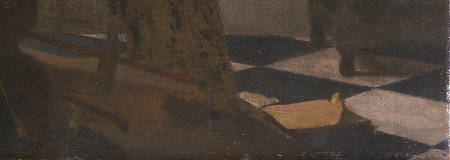
Vermeer specialists have noted that the diagonally placed floor tiles are arbitrarily truncated where they meet the wall, while those of all other Vermeer paintings meet the wall at their tips. This may be a result of retouching or an unusual oversight by the artist. In any case, the perspectival construction of the tiles appears sufficiently accurate, given that, like those of the side window, the orthogonals converge properly on the vanishing point.
The manner in which he transferred his family to Oude Langendijk is not known precisely. Art historians have unanimously discounted the possibility that Vermeer's studio was actually fitted with real black-and-white marble floor tiles. Imported marble flooring was far too expensive for the artist's income—there is no marble native to the Netherlands—and it was probably too heavy for use on upper floors. It is possible, however, that the studio was fitted with small ceramic tiles like those seen in his early "hoe-box" interiors. However, Chris Eckersley, a freelance designer and sculptor, recently suggested that Vermeer may have possessed a stock of real marble tiles and laid them out on the floor in these varying patterns for each of his paintings. After Eckersley read Steadman's calculation that the floor tiles in Vermeer's paintings measured 29.3 cm, he realized that this size is extremely close to half of a Florentine brachia (29.18 cm), which was the standard size of 17th-century Italian marble tiles (presumably from Carrara). However, it is hardly out of the question that the artist used faux tiles made of colored wood, which could be arranged in any pattern. With the collaboration of industrial designer Allan Kuiper (based upon reconstruction drawings by Zantkuijl), Dutch art historian Kees Kaldenbach developed a digital reconstruction of Vermeer's home at Oude Langendijk.
The poor condition of the painting
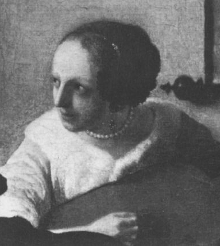
The present work has suffered the ravages of time more than any other painting in Vermeer's oeuvre. The overall tone of the painting is darker than it would have been originally, and large areas of the foreground present evident abrasion. Perhaps only the map conveys some of the work's original finesse. Before the restoration in 1994, the head of the young woman displayed a fancy hairdo, which was restored and slightly retouched.
Notwithstanding the canvas's sorry state, the compositional design is one of Vermeer's finest and can be closely related to the preceding pictures of single women in the corner of a room motif. As in the Woman Holding a Water Pitcher, Vermeer avoided overlapping of the figure and map. The tip of the ball of the lower hanging rod (in Dutch: rollen) nudges curiously into the neck of the figure, energizing the composition.
special topics
- "Uninspired" Dutch music
- The lute in painting
- The Blaeu "dynasty" of Dutch map makers
- Music and love
- In the corner of a room
- A window to another world
- The lute & eroticism
- Dutch furniture: the Spanish chair & extendable table
- Lute iconography
- The lute in art
- A solid composition
- Listen to period lute music
Critical assessment
Vermeer's ladies who hold a lute or guitar are not occupied with music making. They turn away; there is some momentary distraction in the air to draw their attention. They are near discovered playing and they never confront us. The fact is of interest for it illustrates not only Vermeer's temperamental preference, his distaste for anything obtrusively purposeful or demonstrative in his subject but also how it governed his use of the resources of his school.
Lawrence Gowing, Vermeer, 1952
The signature
No signature appears on this work.
(Click here) to access a complete study of Vermeer's signatures.
Dates
c. 1664
Arthur K. Wheelock Jr., The Public and the Private in the Age of Vermeer, London, 2000
c. 1662–1663
Walter Liedtke, Vermeer: The Complete Paintings, New York, 2008
c. 1662–1665
Wayne Franits, Vermeer, 2015
(Click here to access a complete study of the dates of Vermeer's paintings).
Provenance
- Philippus van der Schley and Daniel du Pré sale, Amsterdam (Roos, De Vries and Brondgeest), 22 December, 1817, no. 62, to Coclers;
- [Paris, before 1900; sold to Huntington];
- Collis P. Huntington, New York (until d.1900);
- his widow, Arabella D. Huntington; (from 1913) Mrs: Henry E. Huntington (1900-d.1924);
- their son, Archer Milton Huntington (1924-terminated in 1925);
- The Metropolitan Museum of Art, New York, Bequest of Collis P. Huntington, 1900 (acc. no. 25.110.24).
Exhibitions
- New York September 25–October 9, 1909
The Hudson-Fulton Celebration
Metropolitan Museum of Art
no. 135, lent by Mrs. Collis P. Huntington, New York - New York 8 May–August 1920
Fiftieth Anniversary Exhibition
Metropolitan Museum of Art
8, unnumbered cat., lent by Mrs. Henry E. Huntington - Philadelphia 4 November, 1950–11 February, 1951
Diamond Jubilee Exhibition: Masterpieces of Painting
Philadelphia Museum of Art
no. 42. - New York October 5–November 10, 1971
The Painter's Light
The Metropolitan Museum of Art
8, no. 13. - Leningrad [St. Petersburg] May 22–July 27, 1975
100 Paintings from the Metropolitan Museum
State Hermitage Museum
no. 24 - Moscow Auguts 28–November 2, 1975
100 Paintings from the Metropolitan Museum
State Pushkin Museum
no. 24 - Philadelphia March 18–May 14, 1984
Masters of Seventeenth-Century Dutch Genre Painting
Philadelphia Museum of Art
no. 117 - Berlin June 8–August 12, 1984
Masters of Seventeenth-Century Dutch Genre Painting
Gemäldegalerie, Staatliche Museen Preussischer Kulturbesitz
no. 117 - London September 7–November 18, 1984
Masters of Seventeenth-Century Dutch Genre Painting
Royal Academy of Arts
no. 117 - Stockholm October 2, 1992–January 6, 1993
Rembrandt och Hans Tid
Nationalmuseum
no. 128 - Athens December 13, 1992–April 11, 1993
From El Greco to Cézanne: Masterpieces of European Painting from the National Gallery of Art, Washington, and The Metropolitan Museum of Art, New York
National Gallery Alexandros Soutzos Museum
no. 14 - Osaka April 4–July 2, 2000
The Public and the Private in the Age of Vermeer
Municipal Museum of Art
178–181, no. 32 and ill. - New York March 8–May 27, 2001
Vermeer and the Delft School
The Metropolitan Museum of Art
no. 72 - London June 20–September 16, 2001
Vermeer and the Delft School
National Gallery
no. 72 - Rotterdam October 23, 2004–January 9, 2005
Senses and Sins: Dutch Painters of Daily Life in the Seventeenth Century
Museum Boijmans Van Beuningen
no. 68 - Frankfurt February 10–May 1, 2005
Senses and Sins: Dutch Painters of Daily Life in the Seventeenth Century
Städelsches Kunstinstitut und Städtische Galerie
no. 68 - New York September 18, 2007–January 6, 2008
The Age of Rembrandt: Dutch Paintings in The Metropolitan Museum of Art
The Metropolitan Museum of Art
no catalogue - Tokyo August 2–December 14, 2008
Vermeer and the Delft Style
Metropolitan Art Museum
180–182, no. 29 and ill. - New York September 9–November 29, 2009
Vermeer's Masterpiece "The Milkmaid"
The Metropolitan Museum of Art
no. 8 and ill. - Pasadena Jull 8, 2011–September 26, 2011
The Norton Simon Museum Presents Vermeer's "Woman with a Lute"
Norton Simon Museum
no catalogue - Rome September 27, 2012–January 20, 2013
Vermeer. Il secolo d'oro dell'arte olandese
Scuderie del Quirinale
214, no. 48 and ill. - Naples November 21–February 9, 2016
Woman with a Lute
Museo Capodimonte - Paris February 22–May 22, 2017
Vermeer and the Masters of Genre Painting: Inspiration and Rivalry
Musée du Louvre - Dublin June 1–September 17, 2017
Vermeer and the Masters of Genre Painting: Inspiration and Rivaly
Musée du Louvre - Washington D.C. October 22, 2017–January 21, 2018
Vermeer and the Masters of Genre Painting: Inspiration and Rivalry
Musée du Louvre - Tokyo October 5, 2018 –February 3, 2019
Making the Difference : Vermeer and Dutch Art
Ueno Royal Museum - Amsterdam February 10– June 4, 2023
VERMEER
Rijksmuseum
no. 18 and ill.
(Click here to access a complete, sortable list of the exhibitions of Vermeer's paintings).
| Vermeer's life |
Vermeer's income in the 1660s was probably higher than in the 1670s. In the1660s, sales of paintings and especially his mother-in-law's (Maria Thins) substantial financial contributions together probably ranged from 850 to 1,500 guilders a year. A mason earned about 500 guilders. Vermeer is elected for the first time headsman of the Guild of Saint Luke in Delft at the age of 30 for a two year term. However, by this time many artists resident in Delft had left for the more prosperous Amsterdam and so his election may have had less significance than once believed. He was the youngest artist to become headmaster since the guild was organized in 1611. Many of the luxury items seen in Vermeer's interiors such as the virginal seen in The Music Lesson were economically out of reach of the artist. They may have been lent to him by affluent men of culture or clients such as Diego Duarte, a rich Antwerp banker, in whose important art collection was cited "a young lady playing a clavecin, with accessories, by Vermeer." The virginal seen in Vermeer's Music Lesson was built by Johannes Ruckers. These rare instruments were sold at about 300 guiders, about half the cost of Gerrit Dou, a Frans van Mieris. An averge Dutch house might cost 1,000 guilders. In Delft, hese instruments were owned by the official town musician Scholl. |
| Dutch painting |
Pieter Saendredam (b. 1597) dies in Haarlem. Despite its decline, Delft remained and important city of passage for artists passing from Haarlem, Utrecht and Amsterdam. It contained a number of fine art collections. Ferries parted many times a day to the nearby The Hague and Amsterdam was less than a days away on an inexpensive horse-towed barge. |
| European painting & architecture | André Le Nôtre designs park and gardens of Versailles Louis XIV begins to build palace of Versailles; he makes Charles Lebrun his chief artistic adviser. |
| Music | Composer Henry Lawes dies at London October 21 at age 66. |
| Literature | |
| Science & philosophy | |
| History |
New Amsterdam colonist John Bowne is arrested for permitting Quakers to hold meetings in his Flushing house, completed last year at what will become 37-01 Bowne Street, Queens (see Mathematician-physicist-philosopher-theologian Blaise Pascal dies at the Jansenist Port-Royal monastery in Paris August 19 at age 39. Publication of a world atlas in eleven parts by Joan Blaeu in Amsterdam. Remonstrance, 1657). Bowne is convicted of having violated Governor Peter Stuyvesant's ban on Quaker assemblies. He is jailed and banished, but when he reaches Holland and appeals to the Dutch West India Company, it acquits him of all charges, frees him, and rebukes Governor Stuyvesant, thereby establishing the right to free practice of religious worship. Blaise Pascal proposes the introduction of a public transport system in Paris. Coaches would travel along predetermined routes and take passengers for a small fee. The first coach goes into service during the following year. Founding of the Academia Leopoldina in Vienna The Royal Society receives charter from Charles II. Holland and France form an alliance against possible attack by England. |
| Vermeer's life |
In the early and mid-1660s Vermeer paints a series of extraordinary pictures of single women in the corner of a room absorbed in their activity. Even their most striking passages of observation are always subordinated to the impression made by the whole composition. A French diplomat and art connoisseur Balthasar de Monconys visits Vermeer in Delft. In his diary he notes that he was unable to see any paintings there and had to visit the house of a baker where he saw a painting with a single figure. De Monconys comes initially as a tourist, evidently unaware of Vermeer's presence. A few weeks later, he went to pay his respects in The Hague to Constantijn Huygens, an important art connoisseur and theorist of Dutch culture. De Monconys admired his art collection and described it in detail. However, one can only imagine how amazed Huygens must have been to hear that the Frenchman had been in Delft, without visiting Vermeer. It seems a reasonable assumption that Huygens urged de Monconys to meet with the Delft painter, given the Frenchman's predilection for fine art. Not long afterward, de Monconys did indeed visit with Vermeer at his house, and wrote the following account in his diary journal, which was published in 1665, the year of his death: "In Delft I saw the painter Verme(e)r who did not have any of his works: but we did see one at a baker's, for which six hundred livres had been paid, although it contained but a single figure, for which six pistoles would have been too high a price." Simply put, de Monconys thought the painting he saw was worth less than a tenth of the price mentioned. c. 1663 a son named Johannes, named after himself, is born to Vermeer. |
| Dutch painting |
Rembrandt depicts himself as a bit player in his painting The Raising of the Cross. Jan Steen paints The Drawing Lesson.
Adriaen van de Velde paints Cattle near a Building. Pieter de Hooch, who had moved away from Delft to Amsterdam to seek more patronage, returns to Delft at least once in this year. |
| European painting & architecture |
Bernini: Scala Regia, Vatican, Rome Building of Castle Nymphenburg, near Munich. Nicolas Poussin paints The Four Seasons. France's minister of finance Jean-Baptiste Colbert appoints painter Charles Le Brun director of the Gobelins, which will grow under Le Brun's direction from a small tapestry manufactory into a vast enterprise that supplies all of the royal houses. The Academy of Painting and Sculpture is reorganized, with Le Brun as its director. |
| Music |
Mar 7, Tomaso Antonio Vitali, composer, is born. Pascal: L'Equilibre des liqueurs (posth.) |
| Literature |
The Académie des inscriptions et belles-lettres (the Academy of the Humanities) is founded in Paris. John Milton marries Elizabeth Minshull. |
| Science & philosophy |
Isaac Newton discovers the binomial theorem. Physicist Otto von Guericke invents the first electric generator. It produces static electricity by applying friction against a revolving ball of sulfur, and Guericke will show in 1672 that the electricity can cause the surface of the sulfur ball to glow. |
| History |
Dutch forces hold the best pepper ports of India's Malabar Coast, giving them a virtual stranglehold on the spice trade once controlled by Portugal. A Third Navigation Act adopted by Parliament July 27 forbids English colonists to trade with other European countries. European goods bound for America must be unloaded at English ports and reshipped, even though English export duties and profits to middlemen may make prices prohibitive in America. |
| Vermeer's life |
In a death inventory of the English sculptor Jean Larson, who lived in the Hague, is listed "a head by Vermeer." Some critics believe it may have bee the Girl with a Pearl Earring. In the early to mid-1660s Vermeer refined all the qualities of his mature style. In his orderly designs, Vermeer gave new life to familiar patterns of contemporary genre painting by closely studying the subtleties of appearance. |
| Dutch painting |
Pieter de Hooch paints Young Woman Weighing Gold Jan Steen: paints The Christening Feast. Frans Hals, one of the most fashionable portraitists of his time and now in his late sixties, paints two of his most significant group portraits, the Regents and Regentesses of the Old Men's Alshouse at Haarlem. Owing to his dire poverty he will be given a small allowance by the town of Haarlem. |
| European painting & architecture |
Nicola Poussin paints Apollo and Daphne John Vanbrugh, Eng. architect and dramatist, is born. Christopher Wren: Sheldonian Theatre, Oxford. Francisco de Zurbaran, Spanish painter, dies. |
| Music |
The French horn becomes an orchestral instrument. Oratorio: Christmas Oratorio by Heinrich Schütz at Dresden. |
| Literature |
William Shakespeare - the second impression of the Third Folio, which added seven plays to the thirty-six of the First Folio and the Second: Pericles, Prince of Tyre and six works from the Shakespeare Apocrypha. Thomas Killigrew and the King's Company stage Killigrew's The Parson's Wedding with an all-female cast. Killigrew attempts a similar all-female production of his play Thomaso, though the project is never realized. |
| Science & philosophy |
Robert Hooke discovers the Great Red Spot (an extremely persistent storm) on Jupiter and uses it to determine the period of Jupiter's rotation, which is astonishingly less than ten hours despite Jupiter's great size. Giovanni Alfonso Borelli, calculates the orbit of a comet and finds that it is a parabola (not a circle, ellipse, or line as expected in various earlier theories). Descartes' Traité de l'homme et de la formation de foetus (treatise on man and the formation of the fetus), printed posthumously, describes animals as purely mechanical beings; that is, there is no "vital force" that makes animals different from other material objects. Christiaan Huygens proposes that the length of a pendulum with a period of one second should be the standard unit for length. |
| History |
Aug 29, Adriaen Pieck/Gerrit de Ferry patented a wooden firespout in Amsterdam. New Amsterdam handed over by Peter Stuyvesant to the English, who renames the city New York Amsterdam passes a regulation banning the sale of "rotten, spoiled, or defective spinach, cucumbers, and carrots, ears of corn, radishes, or other fruits [vegetables] because pride could not be taken in or from such things." Slavery is introduced into the Caribbean island of Montserrat and will not be abolished until 1834. The Black Death kills 24,000 in old Amsterdam while the English are taking Nieuw Amsterdam. The plague spreads to Brussels and throughout much of Flanders, and in December it kills two Frenchmen in London's Drury Lane. Men who put the dead into the deadcarts keep their pipes lit in the belief, now widespread, that tobacco smokers will somehow be spared. Samuel Pepys buys forks for his household, but most Englishmen continue to eat with their fingers and will continue to do so until early in the next century lest they be considered effete or, in the opinion of some clergymen, even sacrilegious. A man going out to dinner has for centuries brought his own spoon and knife, the spoon being folded into the pocket and the knife carried in a scabbard attached to the belt; more men now carry folding forks as well. The Kronenbourg Brewery founded in Alsace will continue into the 21st century to produce beer. |
"Uninspired" Dutch music

A Young Woman Playing a Harpsichord
to a Young Man (detail)
Jan Steen
c. 1659
Oil on oak, 42.3 x 33 cm.
National Gallery, London
Because Dutch music was mostly uninventive and undistinguished, Dutch songbooks contained as many French as native airs. Songbooks were collected passionately by amateurs of the well-to-do burghers, typified by the young lute player in this picture. Dutch songbooks typically featured gezelschapslied—a social lyric set to musical accompaniment—containing French and, to a lesser degree, English and Italian pieces.
The principal explanation for the lack of inspiration in Dutch music during the Golden Age of painting has been attributed to diverse circumstances. Among them is the dampening role of the dominant Calvinist religion, which frowned on all music during church services except for unaccompanied congregational singing. Thus, without significant church and aristocratic patronage, there was little incentive for major artistic innovations. Dutch music expert Pieter van Grijp wrote, "As we see it today, the strength of Dutch art lies not so much in its history pieces as in still lifes, landscapes, marines, portraits and genre painting and suchlike. Similarly, the strength of Dutch music lies not in the intricate, polyphonic, or Baroque compositions, but in that simplest of all genres—the song, which enjoyed an incomparable bloom here. This musical strength lay in the sheer delight in singing found among people of all classes, in an appetite for music that was fed and stilled not so much by composers as by poets."
While the simplicity of Dutch music during the Golden Age may be seen as unremarkable in comparison to the complexity of other European traditions, its cultural importance should not be underestimated. Perhaps, analogous to Dutch 17th-century paintings, the lyrics in songbooks served as a reflection of Dutch society—capturing its beliefs, values and everyday experiences in a musical form that was accessible and beloved by people from all walks of life. These pieces may not have changed the course of music history, but they did capture the zeitgeist of a society deeply engaged with its own sense of place and time.
The Blaeu dynasty of Dutch map makers

Portrait of Joan Blaeu
J. van Rossum
Netherlands Maritime Museum, Amsterdam
In a seminal study of Dutch realism, The Art of Describing, art historian Svetlana Alpers focused on what she believes to be a distinguishing and overlooked characteristic of Dutch visual and scientific culture: the "mapping impulse." According to Alpers, in no other time and place did mapping and picturing have such a strong coincidence as in 17th-century Holland. Map makers and map publishers were referred to as "world describers." Both the Dutch painter and the map maker shared the aim of capturing a wide range of knowledge and information about the world on a flat surface.
To be sure, map-making reached an unprecedented level of production and accuracy during this period. Maps were produced in great numbers for both practical and decorative purposes and could be found on the walls of even common Dutch homes. While maps appeared frequently in the paintings of the time, no other artist rendered them with such accuracy or imbued them with such pictorial importance as Vermeer.
Joan Blaeu, a member of a prosperous Amsterdam family of map makers, produced an extraordinary number of decorative maps, some of which were represented by Vermeer. After joining his father's business, Joan published the Atlas Novus (full title: Theatrum orbis terrarum, sive, Atlas novus) in two volumes. Joan and his brother Cornelius assumed control of the studio after their father's death in 1638. Joan then became the official cartographer of the Dutch East India Company.
Around 1649, Joan Blaeu published a collection of Dutch city maps called Tooneel der Steeden (Views of Cities). In 1651, he was elected to the Amsterdam council.
A cosmology was planned as Blaeu's subsequent project, but a fire completely destroyed the studio in February 1672, located at the main printing press on Gravenstraat. Accounts of the incident vary, but it is clear that the damage was substantial, annihilating not only thousands of sheets of paper and printed maps but also copper plates and metal for type, which melted in the heat. Although his other press at Bloemgracht continued operations, the loss for Joan Blaeu was significant. He passed away in Amsterdam the following year.
Love and music
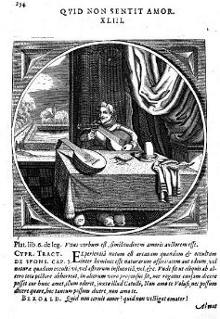
In 17th-century European culture, music and love were closely related, serving as subjects for an endless number of works of art. Specifically, music was often used metaphorically to suggest the harmony between two souls in love. In a familiar emblem, the popular Dutch writer Jacob Cats depicts a lute player in an interior, before an open window, with the caption "Qvid Non Sentit Amor." Beside the man lies another lute, unused. The motto explains that when tuning one lute, the strings of the other instrument begin to resonate, just as two hearts resonate with love even when separated by distance. In this painting, the woman's music may echo in the unattended viola da gamba, a common masculine symbol.
Cats' first book, Sinne- en minnebeelden (1618; "Portraits of Morality and Love"), included engravings accompanied by text in Dutch, Latin and French. Each image offers a threefold interpretation, reflecting what Cats considered to be the three pillars of human life: love, society and religion.
While the dominant Calvinist religion in the Netherlands was strict about music in church settings, focusing primarily on simple hymns, this only seemed to encourage the exploration of more varied and intricate forms of music in domestic and public life. In these settings, music became a tool for expressing romantic and secular love, away from the religious constraints. Instead, the Dutch songbooks of this era often served as manuals of courtship and love, filled with airs and ballads that spanned the emotional spectrum from joyous love to yearning and heartbreak. These songbooks featured the gezelschapslied, (a social lyric set to musical accompaniment) which contained French, and to a lesser degree, English and Italian pieces, and the Dutch burghers took to them with a passion.
In the corner of a room
Striving for complete technical mastery, Vermeer limited his subjects from 1658 onward to a few objects in the left-hand corner of a particular room. Vermeer probably positioned himself near a second window that cast sufficient light on his canvas and working area. The structure and disposition of the windows in the room where Vermeer painted Woman with a Lute are probably analogous to those in The Music Lesson. However, the dim light in the painting would seem incompatible with a second window opened wide enough to allow incoming light sufficient for the purpose of painting. Most likely, Vermeer partially isolated the illuminated working area from the scene he was portraying by using a hanging curtain similar to the one seen in The Art of Painting. The list of protagonists in Vermeer's interiors is short: middle-class men and women in their 20s or 30s, and a few healthy-looking young maids. In only two pictures, Vermeer affords the spectator a glimpse into a second room. The tradition of focusing on the left-hand corner or the left side of the room in interior scenes is notable in Dutch Golden Age painting. Although it is not exclusive to any one artist or school within that period, it was brought to the form we recognize in Vermeer's composition in Southern Holland.
Although modeled on the consolidated left-hand-corner-of-the-room formula that had originated in South Holland, the figures in the Delft interiors are typically set further back in the pictorial space. Delft interior canvases are typically higher than they are wide, a formula that allowed the painter to concentrate on a few tightly knit figures. Rather than spirited actors of earlier interiors who cavort for the amusement of the painter and his audience of the early horizontal compositions of Willem Duyster and Dirck Hals, the figures of the Delft painters strike the spectator as real people. The reasons behind this compositional choice are multifaceted and could include artistic, psychological and cultural considerations.
In Western painting the light source often came from the left in order to avoid the artist's hand casting a shadow on the work. This is a very practical reason that would apply to right-handed artists. It could help to define the spatial elements and give the painting depth and contrast, which were crucial in conveying the sense of a lived-in, three-dimensional space.
In addition, it has be posited that given that the Western tradition reads from left to right, artists arranged their compositions to "read" in this manner, setting the stage on the left-hand side of the painting and allowing the eye to travel naturally from left to right, engaging the viewer in a visual narrative. This can also be tied to storytelling and the desire to stage certain activities or interactions in a way that is immediately comprehensible to the viewer.
In general, light comes from and angle between 30 and 60 degrees in relation to the subject's face. This angle provides a good balance, illuminating the subject's features while casting enough shadow to give a three-dimensional effect.
Top-down lighting is occasionally used in religious or epic themes; the light may come from above to signify divinity or inspiration. Backlighting is employed less frequently as it tends to exalt the atmosphere and the silhouettes of objects, but at the expense of obscuring individual features.
Dutch furniture: the extendable table
The Golden Age witnessed a profound evolution in the function of the home and its furnishings. Houses began to be filled with a great range of sophisticated goods: elaborately carved linen cupboards, tables of all sorts, including extendable tables, tea tables and gaming tables, to say nothing of imported Turkish carpets, Chinese porcelain, Venetian mirrors, Japanese lacquer work and quilts from India. Local production, spurred by foreign competition, also soared in quality and variety far beyond anything seen before.
Late medieval furniture tended to be heavily constructed and limited in number. There were only three basic types of seating: the simple bench (at times with storage capacities), a small three-legged stool (driestal) and in wealthier homes, a large, throne-like armchair for the head of the family. In the 17th century, the Spanish chair could be found in almost any home. It was elegant, lighter and more comfortable than previous seating.

Many modern concepts of domestic life evolved in the Netherlands in this period: devotion to family life, a sense of privacy and pride, which were reflected in the notable order and cleanliness typical of the new Dutch household. However, historian A. J. Schuurman argued that the concept of home comfort, as we know it today, was only fulfilled later in the 19th century with the introduction of the stove and gas light, which significantly improved the quality of daily life. The depictions of thousands of comfortable Dutch interiors appear to be somewhat at odds with Schuurman's opinions.
Another popular piece of furniture found in Vermeer's paintings was the extendable oak table, which appears a great number of times in Dutch interior paintings. Its characteristic bulbous legs can be made out with some difficulty in this work. To the left is an exemplar in the Frans Hals Museum in Haarlem.
Lute iconography
Throughout the centuries, the lute has been one of the most frequently depicted instruments, with the largest variety of iconographical interpretations.
The lute is rich not only in repertoire but also in symbolism. Its refined sound has given it courtly associations in both the East and the West. Conversely, it could serve as an emblem of lust or lasciviousness: in the hands of an older man, it symbolized scandal and degeneracy.
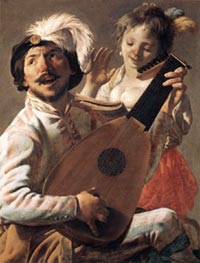
Duet
Hendrick ter Brugghen
1628
Oil on canvas, 101 x 81 cm.
Musée du Louvre, Paris
If the lute's sensuous yet delicate tones evoked the pleasures of love, the fleeting nature of its sound and the fragility of the instrument made it a fitting emblem of transience and death. It is often included, sometimes alongside a skull, in Dutch still-life paintings of the Vanitas variety, illustrating the vanity of worldly existence.
On the other hand, the lute, with its multiple courses (pairs of strings that have to be carefully tuned), could symbolize concord and harmony in matrimony and family life, as evidenced by numerous family portraits featuring musical instruments.
In this painting, Vermeer chose not to furnish a clear-cut explanation for the woman's attitude, preferring instead to suggest a mood with universal resonances. However, he provided two indications that the woman's musing revolves around a distant lover: the map of Europe, which may well allude to foreign travels and the dimly lit viola da gamba under the table. The presence of this second instrument relates to an emblem by Jacob Cats, which describes metaphorically how the resonance of the strings of one musical instrument is felt in another, just as the heartstrings of two lovers sound as one, even when they are separated.
Unfortunately, due to the poor state of conservation of this picture, none of its details, so lovingly portrayed by a host of Dutch painters, can be made out. All indications of the instrument's strings or frets have disappeared, and the delicately carved ornamental soundhole has been reduced to a few unintelligible smudges of paint.
The lute in art
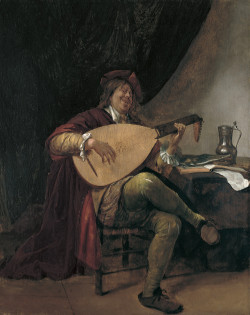
Self-Portrait as a Lutenist
Jan Steen
1652–1655
55 x 44 cm.
Museo Thyssen-Bornemisza, Madrid
Until the invention of the piano, the lute was the dominant solo instrument. Shakespeare was only one of many writers of his day who attributed to the lute the power to transport the listener into a kind of ecstasy; for throughout the Renaissance, the lute's ravishing tone made it the most esteemed and admired of all musical instruments. The fame of the greatest players spread throughout Europe, and the doors of royal courts and palaces were open to them (a number were consequently employed as spies), while instruments by the most famous makers could fetch astronomical sums.
It is not hard to comprehend the appeal of the instrument. Light and portable, it was a harmonizing instrument that was cheaper and easier to maintain than bulky keyboard instruments. It was—and remains—enormously versatile; it was used to play dance music, popular tunes, arrangements of vocal music and song accompaniments, and soon generated a solo repertoire of its own in the form of preludes, passemezzi (a sort of Renaissance twelve-bar blues) and the most refined and expressive fantasias.
The lute had been painted an almost innumerable number of times in European works of art. Other than being a handy source of iconographical inspiration, the lute was frequently used as a training ground for learning the intricacies of drawing objects in perspective. Examination of Dutch genre works, in particular, shows that a number of painters clearly kept it as a studio prop and, naturally, a few (certainly Jan Steen; see image at left) must have actually played it. In some cases, an artist featured the same lute in several paintings. Lutes or even theorbos appear as part of studio furniture in self-portraits as well. For example, in Michael Sweerts' An Artist's Studio, a lovely Italian theorbo (closely related to the lute) lies propped in one corner.
Many 16th-century engravings show the lute being drawn, usually in difficult three-quarter or end-on views (the full face view of the soundboard is relatively straightforward to draw), and at times with the aid of a camera obscura or other optical devices utilized by artists of the time. The lute was also an important ingredient in Vanitas paintings, which represented the transient nature of life. At times, the ephemeral nature of music was conveyed in an even more graphic manner via a broken string or two, or the instrument portrayed face down with obvious finger marks in heavy dust on its glossy back ribs.
Listen to period music
![]() Sarabande [4.99MB], Jean Mercure (c. 1600–1660)
Sarabande [4.99MB], Jean Mercure (c. 1600–1660)
performed by Thomas Berghan
from the M.L. Lutebook, 26r
performed by Thomas Berghan
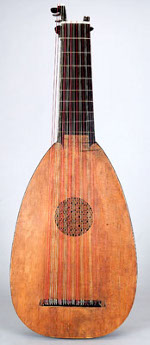
A former bass lute, ca. 1600,
probably built by the Paduan
lutemaker Wendelin Tieffenbrucker,
converted 1734 into a 13-course
Baroque lute by the German
lutemaker Thomas Edlinger,
working in Prague. National Music Museum,
Vermillion, South Dakota (Ex coll.
Carl Des Fours Walderode,
Hrubý Rohozec Castle, Bohemia,
Czech Republic).
The Lute
The name and form of the European lute derive from its early ancestor, the Arab "al 'Ud," literally meaning "wood," probably because the instrument is almost entirely made of various kinds of wood.
Early forms of the lute's ancestors—in various forms and sizes, often with long necks—were found in the former Mesopotamia and Asia Minor (circa 2nd millennium B.C.), later in Egypt. The short-necked lute appeared first in East Asia (China, fifth century A.D.) and as the 'Ud in Arabia (7th–8th century). From there, it was brought to Europe, probably by the Moors to the Iberian Peninsula (8th–9th century), later (circa 1100) by the Saracens to Sicily. The form of the European lute with the turned-back pegbox as a substantial characteristic (presumably to help hold the low-tension strings firmly against the nut) had been developed in Spain during the 13th century. By the 14th century, it was widespread throughout Italy and had made significant inroads into German-speaking areas.
From the 15th to the early 18th century, the lute was the most favored instrument, initially for the accompaniment of the singing voice or as part of the continuo, but with the appearance of great lutenists and composers (Vincenzo Capirola, John Dowland, Alessandro Piccinini or Nicolaes Vallet) and the publication of numerous lute books, it was also used as a solo instrument.
The Western lute has a pear-shaped vaulted back (later rather longer and smaller, like an almond), made up of a number of separate ribs of wood, bent over a mold and glued together edge-to-edge to form the deep, rounded body. At the back of the top end of the neck, the housing for the pegbox is cut out, with the slender, tapering hardwood tuning pegs inserted from the sides.
From circa 1580 onwards, almost all surviving lutes have separate ebony fingerboards, set flush with the soundboard. The soundboard or belly is a flat, thin plate of softwood, often made from two halves joined along the centerline. An ornamental soundhole—the "rose"—is carved into the soundboard (rare instruments may have several little roses). The bridge, holding the strings, was consistently made of light hardwood and was glued directly to the surface of the soundboard.
The strings, made of gut, are arranged in pairs—the courses—being tuned either in unison or at the octave. The number of courses grew from four or five in the Middle Ages to up to fourteen in the Baroque era, requiring some innovations in the lute's structure.
The medieval lute mainly served for accompanying chords to songs and was plucked with a quill, as a plectrum. During the Renaissance era, players began to pluck the strings with the thumb and the following three fingers, thereby gradually turning from the earlier "thumb-in" position to a "thumb-out" position, gaining a greater stretch, which enabled them to reach the increasing number of courses.
A solid composition

The Woman with Lute is one of Vermeer's most simple yet powerful compositions. The play of four rectangles frames a moment in the life of a finely dressed young girl as she glances out the window, distractingly tuning (not playing) her lute. The air of fragility that surrounds her slight figure cannot be fully appreciated by those who are not familiar with the melancholy strains of the lute or its astounding lightness, made of thin strips of wood artfully glued together.
The large wall map of Europe occupies the upper right-hand quarter of the composition. The ball of the hanging rod fits neatly into the crevice between the girl's hairdo and the fur trim of her jacket. The upper tip of the lute's neck is caressed by the horizontal black hanging rod.
Below, the massive dark area created by the chair, table and tablecloth both protects and sustains her from below and offsets the map's visual weight. A long vertical rectangle described by the window and its cast shadow is echoed to the lower right by a chair set flush against the wall.
Vermeer's girl remains wonderfully enclosed in a balanced pictorial world, which she will inhabit for our contemplation for many years to come.
The lute & eroticism
The incredible lightness of the lute contrasts with its formidable weight as a carrier of symbolic meaning in the visual arts. When picking up a lute in hand, any number of associations would have sprung to mind for Dutch citizens of the highest and lowest social rungs. In Vermeer's time, an image of a woman with a lute inevitably led to erotic interpretations unless it belonged to an allegorical series, such as the Muses or the Liberal Arts.

Girl with a Lute
Gerrit van Honthorst
1614
83 x 67 cm.
Private collection
Although the present painting was not construed as an invitation or comment on erotic love, Vermeer must nonetheless have been aware that his image could be interpreted in this light. He deliberately composed his work to make clear the spiritual nature of the meek girl's musical interests. While the lute could connote the vita voluptuosa, with its illicit gratification, it could also symbolize voluptas in the positive sense of the term; that is, music-making as a pleasant pastime, solace or a source of mind-body equilibrium. The latter was almost surely the artist's intention.
In the Netherlands, the lute had a particularly strong sexual connotation owing to the fact that the word for lute, "luit," also meant "vagina." This explains a host of pictorial images from the Low Countries representing prostitutes holding lutes. As Sir Thomas Wyatt observed, the "ideal mistress" described in Pierre de Ronsard's ode to Peletier Du Mans was graced with a lascivious hand, equally well-suited to either lute-playing or love-making:
[With] a naïve spirit, and naïve grace: A lascivious hand, whether she [or it] embraces Her lover, lying in her lap, Or whether [she/it] plays her lute, And with a voice that even surpasses her lute.
Musicologist Albert de Mirimonde believes that because of this type of lewd insinuation, Saint Cecilia is seldom depicted as a lutenist in 16th- and 17th-century works of art. Other than its name, the lute's "anatomy," with its rounded belly, reinforced connections with femininity and, especially, fertility, by evoking pregnancy. The lute also played a prominent role in comedy. The heroines of Thomas Dekker's The Honest Whore and John Marston's The Dutch Courtesan are "professional" lutenists. Shakespeare describes Katharina's ill-fated lute lesson in The Taming of the Shrew.
The lute's belly is made of pine, often only one-sixteenth of an inch thick. Some are so thin that they allow light to pass through. The pear-shaped back is constructed from several ribs, shaped and bent over a mold and then glued together edge to edge. These ribs may be made of sycamore, cedar, yew or cypress. The stringing is light since the body is not able to withstand twelve or more strings at high tension. Plucking is done with the soft part of the fingers and thumb, not the nails. The best lute players use little motion of either hand. During the Baroque period, the lute was replaced by various keyboard instruments that could more easily accommodate the new virtuoso solo and continuo style playing typical of that period.
The lute in painting

A Lady Playing a Lute in an Interior
The Master of the Female Half-Lengths
Active 1530s-1540s
Oil on panel, 54.7 x 42 cm.
Private collection
The number of Dutch paintings from the 1600s featuring a solitary woman or man playing a lute is uncountable. Already in the 1530s and 1540s, the Master of the Female Half-Lengths painted various versions of a stylishly dressed young lady seated behind a table, intent on playing a lute. The lute, as both a musical instrument and a handcrafted object, was so suggestive that various artists portrayed themselves playing lutes in their studios. Italian artist Evaristo Baschenis, who specialized in portraying musical instruments, painted several meticulously rendered still lifes featuring lutes and was particularly skilled in depicting the effect of dust on their overturned, ribbed bellies. The simple yet elegant structure of the lute served as an inexhaustible source for exercises in foreshortening, seemingly for generation after generation.
Various compositional precedents for Vermeer's Woman with a Lute have been proposed, but none as compelling as Woman Playing a Theorbo-Lute by Frans van Mieris, recently proposed by Adriaan E. Waiboer. In Waiboer's words: "Vermeer scholars seem to have overlooked the painting's relationship to Frans van Mieris's Woman Playing a Theorbo-Lute. The Leiden artist represented a three-quarter-length figure playing a theorbo-lute and dressed in a flamboyant outfit. He placed her in an interior with a green curtain, a marble floor and a classical pilaster. She looks sideways to read the score on the table, which creates a remarkable balance between the woman's gaze directed to the left and the neck of the lute extending to the right. Although van Mieris's woman tunes rather than plays the lute, her pose bears a striking resemblance to that of Vermeer's musician. In fact, it cannot be a coincidence that the Delft artist, who appropriated a number of poses from Van Mieris's work in the first half of the 1660s, painted a woman playing a lute in a remarkably similar position."
Moreover, as Waiboer states, despite the fact that "contact between the two artists has not been documented, they unquestionably knew each other personally: their respective residences, Delft and Leiden, were located merely twenty kilometers apart. Vermeer was three years older than van Mieris, but there is little doubt that he looked up to the latter's social and financial status."
The noble lute
The lute is rich not only in repertoire but also in symbolism. Its refined sound has given it courtly associations in both the East and West. Conversely, in the hands of an older man, it could symbolize scandal and degeneracy.
Until the invention of the piano, the lute was the dominant solo instrument. Shakespeare was merely one of many writers of his day who attributed to the lute the power to transport the listener into a kind of ecstasy. Throughout the Renaissance, the lute's captivating tone made it the most esteemed and admired of all musical instruments. The fame of the greatest players spread throughout Europe, and the doors of royal courts and palaces were open to them. A number of these musicians were consequently employed as spies, while instruments by the most renowned makers could fetch astronomical sums.
It is not difficult to understand the appeal of the instrument. Light and portable, cheaper and easier to maintain than keyboards, the lute was—and remains—enormously versatile. It was used to play dance music, popular tunes, arrangements of vocal music and song accompaniments. It soon generated a solo repertoire of its own, in the form of preludes, passemezzi (a sort of Renaissance twelve-bar blues) and the most refined and expressive fantasias.
The lute has been painted an almost innumerable number of times in European works of art. Examination of Dutch genre works, in particular, shows that many painters clearly kept it as a studio prop, and a few, such as Jan Steen, must have actually played it. In some cases, an artist featured the same lute in multiple paintings. Lutes and theorbos, which are closely related to the lute, appear as part of studio furniture in self-portraits as well. For example, in Michael Sweerts' An Artist's Studio, a lovely Italian theorbo lies propped in one corner.

Duet
Hendrick ter Brugghen
1628
Oil on canvas, 101 x 81 cm.
Musée du Louvre, Paris
A window to another world

As Gregor Weber wrote, "Among the most conspicuous qualities of Vermeer's art are the much admired inwardness and tranquillity of his figural scenes. His interiors seem to be isolated from the outside world, as if their inhabitants might exist in their domestic worlds entirely on their own and for themselves. And yet the outer world is present—indeed it must be present in order to achieve the impression of the secure realm of the domestic interior. In this, windows fulfil an important function—they let the outer world appear inside, joining the two spheres."
In no other painting by Vermeer is the sense of yearning and the awareness of what lies outside the room as intangibly present as in this painting, despite the perfect order of the interior with all its accessories. The young musician girl's outward gaze, the map of Europe, and, of course, the window, all evoke a world beyond.
What is she looking at as she distractedly peers outside the room while tuning her lute? Or is she thinking about someone in a faraway land, as suggested by the map of Europe?

A Girl in a Window with a Bunch of Grapes (detail)
Attributed to Gerrit Dou
1662
Oil on panel, 38 x 29 cm.
Galleria Sabauda, Turin
Hans Slager, a Dutch archivist, has noted that, so far, the eight windows in Vermeer's work that feature the same central, quatrelobed geometric design as in the present work, only three have been identified in the works of other artists. One is by Gerrit Dou (1613-1675), titled Girl at Window with a Bunch of Grapes, dated 1660, and is housed in the Royal Collection Trust, UK. Another nearly identical piece by Dou from 1662 is in a private collection belonging to Prinz Eugen von Savoyen in Vienna/Turin. There's also one by Pieter Cornelisz Slingelandt (1640-1691), titled Lacemaker Buying a Cock Through the Window, located in Gemäldegalerie Alte Meister, Dresden, from 1672.
Unfortunately, the condition of the painting is disastrous due to adverse environmental conditions, neglect, and perhaps inexpert cleaning. Despite this, it's possible to discern the pattern of the window, which is the same as in seven other works by Vermeer. The different perspectives in each version suggest that the window was directly observed by the artist.
